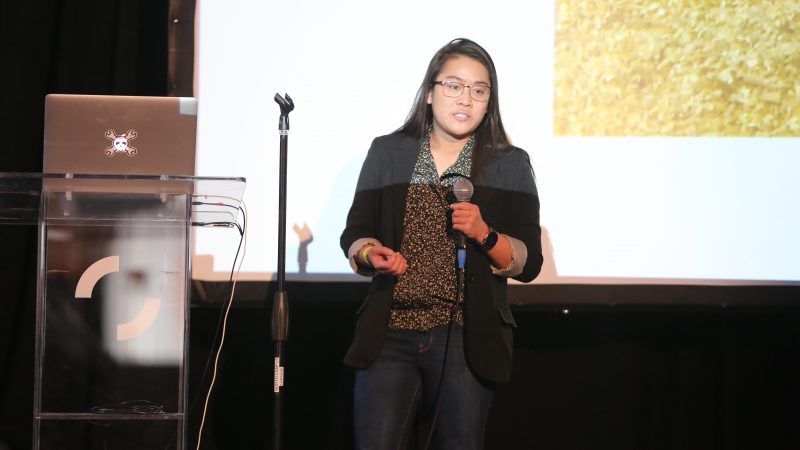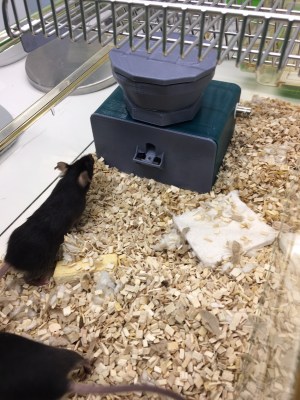When embarking on a career in the life sciences, it seems like the choice of which model organism to study has more than a little to do with how it fits into the researcher’s life. I once had a professor who studied lobsters, ostensibly because they are a great model for many questions in cell biology; in actuality, he just really liked to eat lobster. Another colleague I worked with studied salt transport in shark rectal glands, not because he particularly liked harvesting said glands — makes the sharks a tad grumpy — but because he really liked spending each summer on the beach.
Not everyone gets to pick a fun or delicious model organism, though, and most biologists have had to deal with the rats and mice at some point. It’s hard to believe how needy these creatures can be in terms of care and feeding, and doubly so when feeding is part of the data you’re trying to collect from them. Graduate student Katrina Nguyen learned this the hard way, but rather than let her life be controlled by a bunch of rodents, she hacked a solution that not only improved her life, but also improved her science. She kindly dropped by the Hackaday Superconference to tell us all about how she automated her research.
Your Brain Just Wants You to Eat
It should come as little surprise that people tend to make poor choices about what to stuff in their mouths and when to stop, but the neurological mechanisms that control these behaviors are only poorly understood. Katrina did a stint at the National Institutes of Health to probe this question, using mice as a proxy for humans.
Collecting data for this would seem easy: weigh out food, give it to the mouse, and weigh what’s left later. But as Katrina relates, it’s far more burdensome than that. First of all, one mouse doesn’t make for great statistics, and scaling the feeding process across dozens or hundreds of mice is non-trivial. So is dealing with mundane issues, like commuting into the lab to feed the animals on schedule. It was all taking too much time, and what’s worse, it only offered a broad view of how much food was eaten.
Automating a Critical Mass of Rodent Feeders
Determined to get her life back and get more granular data, Katrina designed an automated feeder for her mice. Such devices are commercially available, of course, but at a cost too high for her lab to bear. Her 3D-printed feeding system, which is entirely open source, can dispense a single food pellet from a hopper into a tray using a small stepper motor. When the mouse picks up the pellet, an Arduino detects it with a phototransistor, records the event on a data logging shield, and dispenses a fresh nugget.
It sounds simple enough, but it took many iterations to get to a final design, and even then it’s not perfect — pellets sometimes misbehave on the way down the chute. It also has no connectivity, so the next version will add WiFi for easier integration and data capture. That said, the design is good enough to have attracted the attention of labs all over the world, who have downloaded Katrina’s design and built their own version of the device. That’s the power of open source, and hats off to Katrina for sharing her hard-won experience for the benefit of all.
Speaking from personal experience, I have a word of warning for Katrina: Be careful, because you might just find that building devices like this ends up being more interesting than the science it supports. That’s how it turned out for me, anyway.
















I wonder if the mice change their behavior when the whole meal worth of food is visible at once, versus only being revealed one pellet at a time…
Don’t know about mice, but mine’s definitely different, especially when it comes to chips. I buy a box of small vending machine-sized bags because I feel a twinge of guilt if I eat more than one. Oftentimes that’s enough to stop me. If I get a big party-sized bag, it’s harder for me to stop after a similar portion.
But you know the whole box is there. I think I’d get anxiety not knowing if future food was guaranteed, and try to eat as much as I could while it seemed to be forthcoming…
Biologists tend to be pretty good hackers. I remember back then (1975s) a friend of mine wanted to get a correlation between a bee’s “load” and the distance to the nectar source.
For that, you’ve got to weigh the bee. He trained them on a source in the lab which was accessible to them via a short dark tunnel. Bees don’t fly in the dark, but walk.
The tunnel’s floor was a very thin metallized plastic foil which warped under the bee’s weight; the warping was measured capacitively. You got one measure before, one after feeding.
The foil? There was a nearby capacitor factory.
As a phisics student myself, I remember I was very impressed with this guy.
“Not everyone gets to pick a fun or delicious model organism, though.” I had an uncle who, as a grad student, was assigned a project that needed a bigger mammal than a rat, so he was working with guinea pigs. Grad student budgets being what they are, he decided to take the leftover model organism bodies home for dinner. That worked fairly well until he tried to cook one which had been killed with ether. Apparently that isn’t a good marinade.